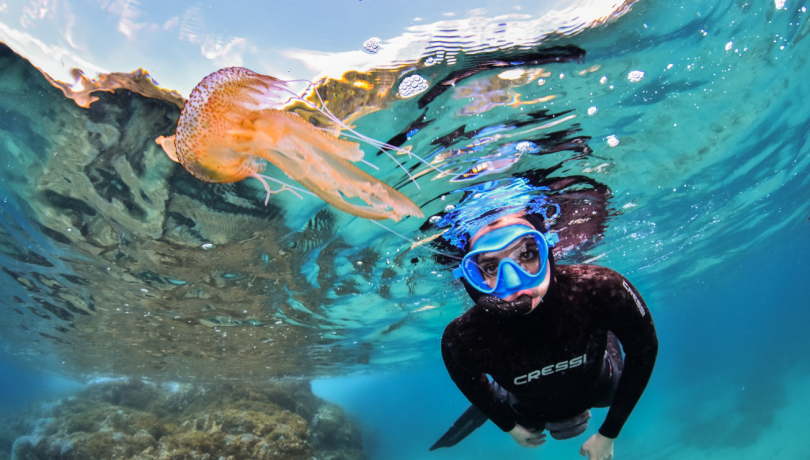The Barcelona metropolitan area has been one of the 690 regions worldwide that have contributed to the City Nature Challenge, an international challenge to discover the nature of cities.

Documenting biodiversity in urban areas worldwide simultaneously over four days is the aim of the City Nature Challenge, a friendly competition held between April 26th and 29th in 690 cities and metropolitan regions worldwide. For the second consecutive year, the metropolitan area of Barcelona has joined the global challenge to photograph as much urban wildlife as possible, adopting the local name of the event as BioDiverCiutat.
With the coordination of the Institute of Marine Sciences (ICM-CSIC) and the collaboration of various environmental entities, the Barcelona metropolis recorded, over the four days of the competition, a total of 3,514 observations on the citizen science observatory MINKA, corresponding to 739 different species, 50% of which were marine.
Throughout the bioblitz, citizens have been the driving force behind making the Barcelona metropolitan area the region with the highest number of observation records and species among the 15 Spanish populations participating in the global challenge, highlighting the contribution of marine observations.
"In Barcelona and its municipalities, we have the advantage of having a wide range of ecosystems, which allows us to obtain a great diversity of species when organizing citizen science events," emphasizes Jaume Piera, researcher at the ICM-CSIC and leader of the initiative.
Most of the coastal observations were made thanks to photographic outings and daytime and nighttime biodiversity censuses carried out by the Catalan Federation of Underwater Activities (FECDAS), snorkeling outings by the company Anèl·lides - Serveis Ambientals Marins, and outings to metropolitan beaches within the BioPlatgesMet project, co-led by the Barcelona Metropolitan Area (AMB) and the ICM-CSIC.
Discovery of an Atlantic nudibranch species for the first time on the coast of Barcelona
Among all the species recorded in the challenge, the finding of a specimen of nudibranch stands out, which until now had not been cited in the city of Barcelona. It is the species Tergipes tergipes, a mollusk of Atlantic origin found specifically in the breakwater area of Llevant Beach in Barcelona. The author of the finding, Xavier Salvador, who is also a technician at the ICM-CSIC and a member of the BioDiverCiutat organization, emphasizes that "it is not common to find this species in the Mediterranean Sea because it feeds only on certain species of hydrozoans and at shallow depths, limiting its presence to very specific locations."
The first record of the species in Catalonia was in a shallow area of Sitges, and currently, there are very few documented cases on the Catalan coast, according to the Biodiversity Database of Catalonia and the Global Biodiversity Information Facility (GBIF).
The ranking of the ten most cited species in the Barcelona metropolitan region within BioDiverCiutat is led by the anemone goby fish (Gobius incognitus), a common fish in the Mediterranean Sea that was recorded 100 times on the MINKA platform over the four days. The second most cited species has been the sea snail Cerithium vulgatum, and the third, the brown alga (Dictyota dichotoma). BioDiverCiutat also recorded 61 exotic species, 26 of which are invasive, such as the red alga Asparagopsis taxiformis and the marine polychaete Branchiomma luctuosum, both also in the ranking of the ten most cited.
The tally also includes four threatened species or included in some form of protection, such as the plant Echium arenarium, typical of dune ecosystems and found on the beaches of Viladecans; the Audouin's gull (Ichthyaetus audouinii), sighted at Can Camins Beach in Prat de Llobregat; the marine phanerogam Cymodocea nodosa, observed at Llevant Beach, and the date mussel (Lithophaga lithophaga), found in the Forum Baths.
"The Forum area of Barcelona stands out for its uniqueness: an artificial seabed with uncommon structures in nature, protected from waves and fishing. This protection often results in a great diversity of species being observed, some of which are difficult to find elsewhere," explains biologist Xavier Salvador.
Torrelles de Llobregat and Viladecans emerge as top contributors following Barcelona city
The Torrellenca Naturalist Association, an entity that already contributes continuously to the MINKA platform, also played a prominent role in the competition. The municipality contributed 247 observations of 99 different species, highlighting the discovery of the insect Fibla hesperica, recorded for the first time on the MINKA platform; the Spanish pond turtle (Mauremys leprosa), categorized as vulnerable according to the International Union for Conservation of Nature (IUCN) Red List; and the painted lady butterfly (Vanessa cardui), a lepidopteran that can make an annual migration of 10,000 kilometers.
Viladecans was the third most active population in the competition, contributing 225 observations and 91 different species, mainly from the beach area, where several specimens of the by-the-wind sailor (Velella velella) were recorded, which were abundant on various beaches in Catalonia at that time. In this locality, a group of volunteers from the Barraquer Ophthalmology Center participated, which maintains an ongoing collaboration with the ICM-CSIC, to also contribute to the challenge.
MINKA consolidates as a key citizen tool for exploring coastal biodiversity
The organization of the City Nature Challenge, which promotes the use of various citizen science platforms similar to MINKA, celebrates its ninth edition as the most participatory, with 83,000 participants from 690 cities in 51 different countries, and documenting nearly 2.5 million observations of urban wildlife, comprising 65,682 different species. Although the four days of the challenge in Barcelona were marked by rain, researcher Jaume Piera highlights that "the results of BioDiverCiutat demonstrate people's interest and willingness to participate in citizen science activities to discover nature, especially in the marine environment."
The observations collected in MINKA, which has a website and app, are already incorporated into global biodiversity repositories such as GBIF and are used in biodiversity management initiatives, such as the creation of marine layers in the Biodiversity Atlas of the Barcelona City Council and the management and conservation of metropolitan beaches through the BioPlatgesMet project. The BioDiverCiutat event was funded by the European projects ANERIS, GUARDEN, MINKE, and ECS.